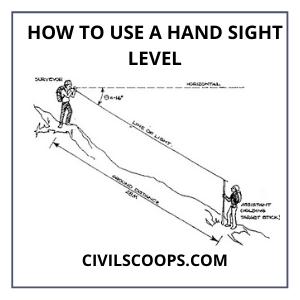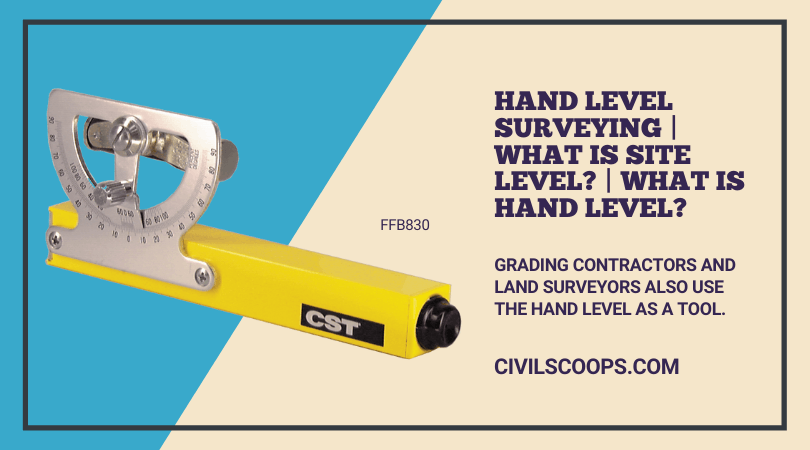Hand Level Surveying | What Is Site Level? | What Is Hand Level? | How to Use a Hand Sight Level | Estimating Distances with a Sight Level
Table of Contents
Hand Level Surveying
- Grading contractors and land surveyors also use the hand level as a tool.
- To find a height or horizontal space, a hand level compares several points to a reference point.
- For preliminary land survey jobs, basic distance measuring, or any other site task, hand level surveying is perfect.
- Since it does not need a tripod stand or levelling instrument rig, hand level surveying saves us time.
- Contractors also use hand level surveying because it is a fast operation.
- Sight level, pocket level, and Abney level are all terms used to describe hand level.
Also Read: Building Layout | How to Building Layout | Construction Layout Techniques
What Is Site Level?
- The bare minimum you’ll need to competently plan a construction design on a property is site levels. We recommend that you have these before you start writing (or mouse to mouse pad). It will save you a lot of time later.
- This method is suitable for a construction site or one that needs to be cleaned of all structures in preparation for a new creation.
- They help you predict the height of a building about ground levels and recession jets, and they’re also useful if the council has set a minimum floor level. They’re also good for draining stormwater to the road’s edge.
What Is Hand Level?
- When levelling, a hand level is a small levelling device that is kept in hand. It is made up of a 100 to 150 mm long rectangular tube.
- A hand level (also known as a light level or hand sight level) is an instrument used for estimating rather than precision levelling. Within a telescope, a hand level is basically a spirit level. Grading contractors and land surveyors often use the instrument to equate several points to a reference point to obtain approximations of level or distance.
- When opposed to putting up a tripod and levelling instrument, hand levels save time. The trade-off is that, while hand levels take much less time to set up, they are much less precise than precision instruments.
- Sight ranges are useful for preliminary surveying and determining distances. Bricklaying, fencing, and laying a lawn are examples of projects where hand sight levels are desirable. Using a hand sight level may help most DIY projects around the house that need some level estimation.
How to Use a Hand Sight Level

- Look through the tiny opening while keeping the gadget at eye level.
- Due to a lack of incoming light, it was difficult to see the bubble.
- Lift or lower the front end of the sight angle until the bubble centres on the middle line in the viewing pane, depending on the reference point.
- You’ve found a level where the bubble centres on the middle line.
- Resting the device on a flat surface is an alternative to keeping the hand straight. This approach would have a more precise level reading.
Also Read: How to Building Construction Process Step by Step
Estimating Distances with a Sight Level
- A sight level, as well as a sighting rod, could also be used to estimate distances between both the user and also another object.
- Start by taking a look around the unit. The lines at the high and low ends of the viewing window are worth noting. The difference between the bottom and the top is usually 1:12.
- The customer is 36 feet away from its rod unless the top line is at 6 feet, as well as the bottom line is now at 3 feet, as seen from the range angle.
- So this is how it works in mathematics. First, describe the difference in the viewing window seen between two distances: 6 – 3 means 3. To transform from the distance proportional to the real distance, compare the difference and measure it by 12: 36 = 3 x 12
- A hand level, also recognized as a hand sight level or a sight level, is a hand-held optical instrument with a spirit level integrated into a telescope.
What Are the Functions of Hand Levels?
In preliminary land surveying, hand levels are used for uneven levelling and distance measurement. This kind of pocket sight level is often used by surveyors and excavating contractors for grading, comparing reference points, and estimating distances and heights.
How Accurate Are Hand Levels?
Hand levels are not made to be as precise as precision instruments because they are constructed for rugged levelling. They normally have stadia lines, spirit stages, and 1 to 2.5 x magnification for accurate effects.
What Is the Best Way to Use a Hand Level?
- To begin, lift your tool to eye level and look through the eyepiece at the point of reference. Therefore, for the far end of the instrument tilted up and down, focus the bubble.
- This indicates that it has reached a degree. Place the hand level on a level surface until sighting the point of reference for even more precise scaling.
- Because construction projects are time-sensitive, not all measurements or levels must be exact. Professionals will also get approximations rather than precise results when checking whether structures or artefacts are completely levelled.
- Rough levelling or measuring levels and distances are common in DIY designs, fencing, and bricklaying, and a hand level is the best method for the job. This pocket-sized instrument, also known as a hand sight level, can appear to be a monocular at first glance, but it has all of the features required for levelling.
- An objective lens and an integral bubble level make up hand levels, which are the essential components for checking levels and measurements.
- As compared to other levelling devices that may be installed on tripods, these levels require very little time to set up, if at all. In reality, all you have to do is look through the hand level’s eyepiece and centre the bubble, and you’ll be ready to read the level or measurements.
- The hand levels available on Engineer Warehouse have stadia lines, sunglasses, and slidable eyepieces to help you concentrate your vision.
[note note_color=”#F2F2F2 ” text_color=”#333333″ radius=”3″ class=”” id=””]
Like this post? Share it with your friends!
Suggested Read –
- Types of Cement Grades | Difference Between 33, 43 &53 Grade Cement
- What Is Panelled Window? | What Is Glazed Window? | Difference Between Paneled Window and Glazed Window
- What Is Fresh Concrete? | Properties of Fresh Concrete | Factors Affecting Workability
- What Is Flyash Brick? | Fly Ash Bricks Cost | Properties of Flyash Bricks | Fly Ash Bricks Manufacturing Process | Compressive Strength of Fly Ash Brick | Fly Ash Brick Size | Advantages &Disadvantages of Fly Ash Bricks
- What Is Estimate? | Types of Estimate | Advantage of Estimate | Disadvantage of Estimate
[/note]
Originally posted 2021-08-31 07:55:17.

